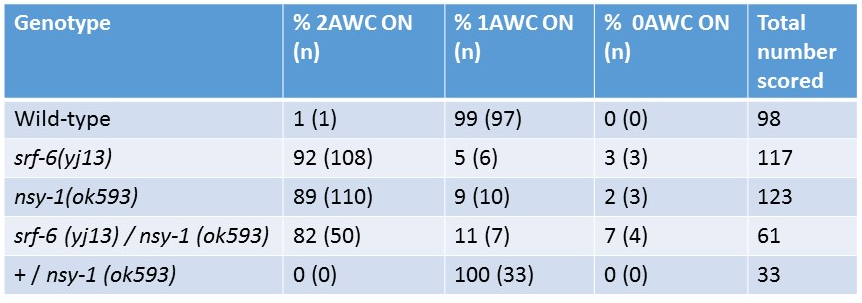Department of Chemistry and Biochemistry, Worcester Polytechnic Institute, Worcester, MA
Description
C. elegans srf-6 mutants were isolated using altered surface immunofluorescence as phenotype (Hemmer et al., 1991; Grenache et al., 1996). In Van Sciver et al., 2019, we showed by whole genome sequencing that three different srf-6 mutants carry mutations in gene nsy-1. Well-characterized mutant alleles of nsy-1 result in hermaphrodites that express the olfactory receptor gene str-2 in both AWC neurons (2AWCON, Troemel et al., 1999), unlike wild type hermaphrodites, which express str-2 asymmetrically in only one of the two AWC neurons (1AWCON, Troemel et al., 1999). Our sequencing results suggested that srf-6 mutants might have a similar 2AWCONphenotype. We therefore examined srf-6(yj13) for its AWC phenotype.
In order to introduce an str-2::GFP marker into the srf-6 genotype, first srf-6(yj13) unc-4(e120) II and nsy-1(ok593) unc-4(e120) II double mutants were constructed as described (Hemmer et al., 1991). Homozygous males carrying the construct kyIs140, which contains an str-2::GFP fusion integrated on chromosome I (Troemel et al., 1999), were mated with srf-6(yj13) unc-4(e120) II hermaphrodites, and an Unc F2 hermaphrodite expressing GFP in chemosensory neuron AWC was cloned. An individual hermaphrodite descendant, all of whose offspring expressed GFP, was isolated to establish a strain of genotype kyls140 I; srf-6(yj13) unc-4(e120) II. A strain of genotypekyls140 I; nsy-1(ok593) unc-4(e120) was constructed similarly. Adult hermaphrodites from these strains were examined in a fluorescent microscope for their AWC phenotype. Figure 1 shows that srf-6(yj13) adults exhibited a 2AWCON phenotype similar to that of nsy-1(ok593).
To test whether srf-6(yj13) and nsy-1(ok593) affect the same or different genetic functions, a complementation test was performed (Figure 1, last two lines). Males of genotype srf-6(yj13) were mated with kyls140 I; nsy-1(ok593) unc-4(e120) II hermaphrodites, and non-Unc offspring were scored in a fluorescent microscope for the AWC phenotype. The complementation heterozygotes showed a 2AWCON phenotype similar to that of nsy-1(ok593). This result included data from two separate crosses. In contrast, when wild type males were mated with kyls140 I; nsy-1(ok593) unc-4(e120) II hermaphrodites, the 1AWCONphenotype was observed. These results included worms from one cross.
These results indicate that srf-6(yj13) and nsy-1(ok593) mutations do not complement each other for the 2AWCON phenotype, and together with the srf-6 mutant sequencing results (Van Sciver et al., 2019), we conclude that srf-6 and nsy-1 are the same gene.
Reagents
C. elegans Strains
N2 C. elegans wild type
CX3695 kyIs140 [str-2::GFP + lin-15(+)] I
AT18 srf-6(yj13) II
AT19 srf-6(yj13) unc-4(e120) II
VC390 nsy-1(ok593) II
AT28: srf-6(yj13) unc-4(e120) II; kyIs140 [str-2::GFP + lin-15(+)] I
AT29: nsy-1(ok593) unc-4(e120) II
AT30: nsy-1(ok593) unc-4(e120) II; kyIs140[str-2::GFP + lin-15(+)] I
Strains N2, CX3695, and VC390 are available from the CGC. Strains AT28 and AT30 will be submitted to the CGC.
Acknowledgments
Some strains were provided by the Caenorhabditis Genetics Center, which is funded by NIH Office of Research Infrastructure Programs (P40 OD010440). The authors thank colleagues Elizabeth Ryder and Jagan Srinivasan for comments on the manuscript.
References
Funding
This work was partially funded by the Office of the Dean of Arts and Sciences, Worcester Polytechnic Institute, Worcester, MA.
Reviewed By
Maria Gravato-NobreHistory
Received: June 18, 2019Accepted: June 27, 2019
Published: July 4, 2019
Copyright
© 2019 by the authors. This is an open-access article distributed under the terms of the Creative Commons Attribution 4.0 International (CC BY 4.0) License, which permits unrestricted use, distribution, and reproduction in any medium, provided the original author and source are credited.Citation
Honzel, BE; Foley, SJ; Politz, SM (2019). C. elegans srf-6 and nsy-1 mutations result in a similar 2AWCDownload: RIS BibTeX




